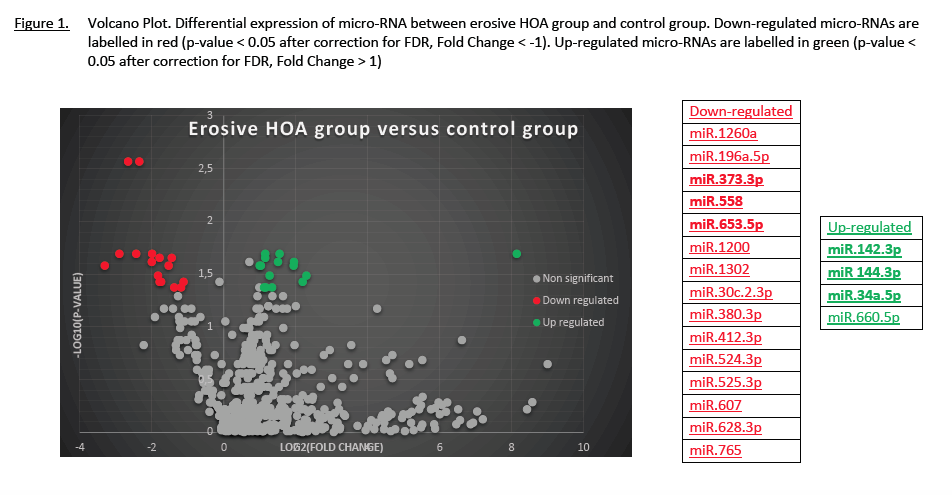Back
Poster Session A
Osteoarthritis (OA) and related disorders
Session: (0017–0033) Osteoarthritis and Joint Biology – Basic Science Poster
0023: New Biomarkers in Hand Osteoarthritis: The Micro-RNA Signature
Saturday, November 12, 2022
1:00 PM – 3:00 PM Eastern Time
Location: Virtual Poster Hall
- MA
Maxime AUROUX, MD
Hospices Civils de Lyon
Lyon, France
Abstract Poster Presenter(s)
Maxime Auroux1, Marjorie Millet2, Blandine Merle2, Elisabeth Fontanges1, Florence Duvert1, Evelyne Gineyts3, Jean-Charles Rousseau3, Olivier Borel2, Alexandre Mercier1, Eric LESPESSAILLES4 and Roland Chapurlat1, 1Hospices Civils de Lyon, LYON, France, 2INSERM U1033, LYON, France, 3INSERM 1033, Lyon, France, 4Regional hospital centre of Orleans, France, ORLEANS, Centre, France
Background/Purpose: Hand osteoarthritis (HOA) is a highly prevalent disease, associated with important disability and socio-economic burden. Erosive HOA, almost exclusively found in women, induces more disability, but the pathophysiology is poorly known. Susceptibility genes identified to date only explain a minor proportion of the risk. We have hypothesized that epigenetic processes could play a role and we focused on micro-RNAs, which are small noncoding RNAs interfering with messenger RNAs, leading to their repression or destruction, as potential regulators involved in the pathophysiology of HOA.
Methods: We have assessed HOA status according to ACR criteria for HOA in 1189 post-menopausal women (the QUALYOR Study). We have studied the micro-RNA signature in two steps. First, in the screening phase, we have measured in blood samples the 768 most-described micro-RNAs using Taqman Low Density Array cards (TLDA) after RNA extraction, micro-RNAs reverse transcription and pre-amplification, in 3 different groups: 10 patients with erosive HOA (at least 3 erosive joints), 10 patients with symptomatic HOA without erosions and 10 controls without HOA matched for age and BMI. We have pairwise compared each micro-RNA expression level between HOA groups using Wilcoxon test. The p-values were corrected for false discovery rate (FDR) with the Benjamini-Hochberg method and were considered significant for values < 0.05. In a second step, we will proceed to the validation of micro-RNAs identified at screening phase in larger samples (60 patients with erosive HOA and 60 patients without HOA).
Results: We have first compared micro-RNAs expression levels between the erosive HOA group and controls. After exclusion of micro-RNAs weakly expressed and those that do not segregate clearly between groups, we have identified 12 down-regulated micro-RNAs and 4 up-regulated micro-RNAs. Among these, 4 down regulated (miR 373-3p, miR 558, miR 607 and miR 653-5p) and 3 up-regulated micro-RNAs (miR 142-3p, miR 144-3p and miR 34a-5p) were previously described in chondrocytes homeostasis or osteoarthritis. We have then compared micro-RNAs expression level between erosive HOA and non-erosive HOA but did not find any significant difference, possibly suggesting that even if these two HOA phenotypes are clinically different, some of the pathophysiological mechanisms might be shared.
Conclusion: We have identified for the first time in HOA a micro-RNA signature associated to the disease, that will be validated in the second step of the study. This micro-RNA signature could become a biomarker of interest and could help better understanding the pathophysiology.

Disclosures: M. Auroux, None; M. Millet, None; B. Merle, None; E. Fontanges, None; F. Duvert, None; E. Gineyts, None; J. Rousseau, None; O. Borel, None; A. Mercier, None; E. LESPESSAILLES, None; R. Chapurlat, None.
Background/Purpose: Hand osteoarthritis (HOA) is a highly prevalent disease, associated with important disability and socio-economic burden. Erosive HOA, almost exclusively found in women, induces more disability, but the pathophysiology is poorly known. Susceptibility genes identified to date only explain a minor proportion of the risk. We have hypothesized that epigenetic processes could play a role and we focused on micro-RNAs, which are small noncoding RNAs interfering with messenger RNAs, leading to their repression or destruction, as potential regulators involved in the pathophysiology of HOA.
Methods: We have assessed HOA status according to ACR criteria for HOA in 1189 post-menopausal women (the QUALYOR Study). We have studied the micro-RNA signature in two steps. First, in the screening phase, we have measured in blood samples the 768 most-described micro-RNAs using Taqman Low Density Array cards (TLDA) after RNA extraction, micro-RNAs reverse transcription and pre-amplification, in 3 different groups: 10 patients with erosive HOA (at least 3 erosive joints), 10 patients with symptomatic HOA without erosions and 10 controls without HOA matched for age and BMI. We have pairwise compared each micro-RNA expression level between HOA groups using Wilcoxon test. The p-values were corrected for false discovery rate (FDR) with the Benjamini-Hochberg method and were considered significant for values < 0.05. In a second step, we will proceed to the validation of micro-RNAs identified at screening phase in larger samples (60 patients with erosive HOA and 60 patients without HOA).
Results: We have first compared micro-RNAs expression levels between the erosive HOA group and controls. After exclusion of micro-RNAs weakly expressed and those that do not segregate clearly between groups, we have identified 12 down-regulated micro-RNAs and 4 up-regulated micro-RNAs. Among these, 4 down regulated (miR 373-3p, miR 558, miR 607 and miR 653-5p) and 3 up-regulated micro-RNAs (miR 142-3p, miR 144-3p and miR 34a-5p) were previously described in chondrocytes homeostasis or osteoarthritis. We have then compared micro-RNAs expression level between erosive HOA and non-erosive HOA but did not find any significant difference, possibly suggesting that even if these two HOA phenotypes are clinically different, some of the pathophysiological mechanisms might be shared.
Conclusion: We have identified for the first time in HOA a micro-RNA signature associated to the disease, that will be validated in the second step of the study. This micro-RNA signature could become a biomarker of interest and could help better understanding the pathophysiology.

Disclosures: M. Auroux, None; M. Millet, None; B. Merle, None; E. Fontanges, None; F. Duvert, None; E. Gineyts, None; J. Rousseau, None; O. Borel, None; A. Mercier, None; E. LESPESSAILLES, None; R. Chapurlat, None.

